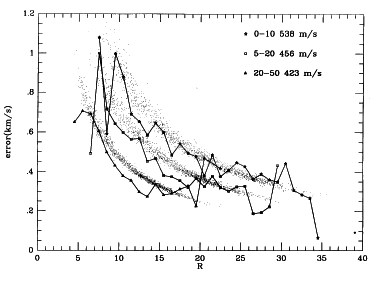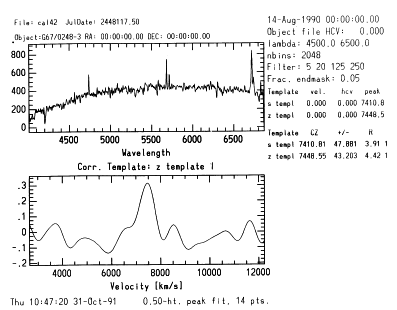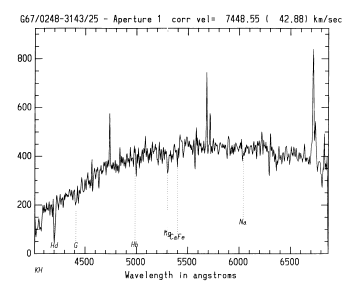
Michael J. Kurtz, Douglas J. Mink, William F. Wyatt, Daniel G.
Fabricant, and Guillermo Torres
Harvard-Smithsonian Center for Astrophysics, Cambridge, MA 02138
Gerard A. Kriss
Department of Physics and Astronomy, Johns Hopkins University,
Baltimore, MD 21218
John L. Tonry
Department of Physics, MIT, Cambridge, MA 02139
in Astronomical Data Analysis Software and Systems I, ASP Conf. Ser., Vol. 25, eds. D.M. Worrall, C. Biemesderfer, and J. Barnes, p. 432-438
XCSAO is a software package for obtaining radial velocities of stars and galaxies from optical spectra using the cross-correlation method. It has been written to work within the IRAF environment, and is compatible with other packages being developed at SAO for optical spectra. We discuss the individual components of the package in terms of the decisions required to set up the package for a new instrument/observing program. Using artificial spectra we show the procedures necessary to optimize the set up parameters, and demonstrate the robustness of the package when applied to spectra from both stars and galaxies.
Keywords Data Analysis, Spectra, Radial Velocities, Redshifts
Copies of the source and IRAF installation scripts can be obtained by anonymous FTP at ftp://cfa-ftp.harvard.edu/pub/iraf/rvsao.tar.Z. A Readme file can be found in the same directory. XCSAO has been extensively tested on Decstations and Sparcstations and is expected to experience no major changes. EMSAO is still undergoing substantial revision. Both tasks have been in production use at SAO for the past year, and are currently in production use by several large redshift and radial velocity programs worldwide.
XCSAO has its origins in the XCOR program written by Gerry Kriss, as well as the FORTH code, and a FORTRAN rendition of it by Tonry. Eventually we included the continuum estimation methods from Mike Fitzpatrick's FXCOR. Our code was written and is being maintained by Doug Mink.
This paper presents a very brief overview of the capabilities of XCSAO, and some of the testing procedures we have developed for it. An extensive description of the program is in preparation for PASP (Kurtz, et al. 1992).
Note that this binning suggests that it is worthwhile to have the template cover the broadest wavelength range possible, at a dispersion equal or better than the unknown's, the rebinning will then choose the proper wavelength region for maximal overlap, with the resolution determined by the unknown. We find that it is in all cases better to rebin to the next larger power of two than the number of actual pixels, rather than the next smaller.
If EMCHOP=yes XCSAO will remove emission lines and replace them with the value of the continuum before performing the cross corelation. The emission lines are found using ICFIT, with parameters settable as for the continuum supression; the method for finding emission lines here is similar to that used in the sister task EMSAO. Removing emission lines is critical to finding absorption line redshifts from galaxies with emission lines, if the spectrum is too noisy for the emission line removal, or if it has sharp spurious absorption features from poor sky subtraction we recommend that the offending regions be exised by hand, using SPLOT.
error = (3w)/(8(1+r))
where w is the FWHM of the correlation peak, and r is the ratio of the correlation peak height to the amplitude of the antisymmetric noise.
For large observing programs a better error estimate may be obtained. The coefficient 3/8 w is for many situations a constant, and may be estimated by taking the mean of a number of measures. The error estimate then becomes a constant divided by (1 + r). This is not in all cases possible, for example when the low pass fourier roll-on is changed the relation of r with error changes. 3/8 w tracks this properly. Figure II shows the calculated errors (dots) versus the actual mean errors (solid lines) as a function of the r statistic for three different low-pass filters; note that the calculated errors do track the actual errors, but that the relation of r with error changes.



We have tested XCSAO with synthetic spectra created to have a specified number of counts sampled from a parent distribution, which is a template spectrum. For tests of echelle spectra we used Kurucz models for the templates, for tests of galaxy spectra we used high S/N observations. Note that we can know the true radial velocity difference between the unknowns and the templates either exactly in the case of models, or where the template spectrum was exactly the one used to create the synthetic spectra, or with very high accuaracy, as when the radial velocity template is different from the template used to create the synthetic spectra.
The data used to create Figure II were 1200 synthetic spectra created from a Kurucz model of a 5500K dwarf, and having between 5000 and 30,000 total counts. The template used for cross correlation was exactly the same template as was used to create the synthetic spectra. A complete description of the testing procedures will be found in Kurtz, et al. (1992).
Steve Levine and John Morse made important contributions to the development of the code. Dave Latham, Alejandra Milone, Susan Tokaraz, and John Huchra have contributed mightily of their expertise. Much of the IRAF code we have used was written by Mike Fitzpatrick and Frank Valdes.
Hassab, J.C. and Boucher, R.E. 1979, IEEE Trans. Acoust. Speech Signal Process., ASSP-27, 922
Kurtz, M.J., Mink, D.J., Wyatt, W.F., Fabricant, D.G., Torres, G., Kriss, G.A., and Tonry, J.L. 1992, Pub. Astron. Soc. Pacific, to be submitted
Tody, D. 1986, in Instrumentation in Astronomy VI, ed. D.L. Crawford, Proc. SPIE 627, 733
Tonry, J.L. and Davis, M. 1979, A Survey of Galaxy Redshifts I. Data Reduction, Astron. J., 84, 1511 [abstract] [full text]
Tonry, J.L. and Wyatt, W.F. 1988, CFA Z-Machine Data Analysis Software, Cambridge: Smithsonian Astrophysical Observatory